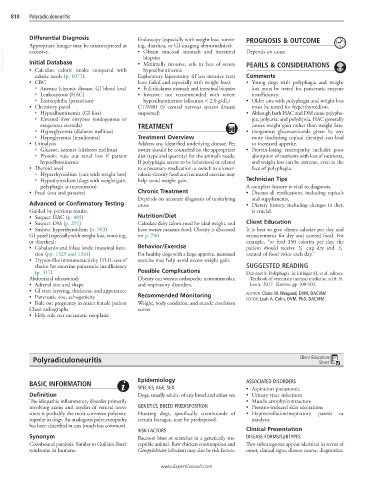Page 1608 - Cote clinical veterinary advisor dogs and cats 4th
P. 1608
810 Polyradiculoneuritis
Differential Diagnosis Endoscopy (especially with weight loss, vomit- PROGNOSIS & OUTCOME
Appropriate hunger may be misinterpreted as ing, diarrhea, or GI imaging abnormalities): Depends on cause
VetBooks.ir Initial Database • Minimally invasive, safe in face of severe PEARLS & CONSIDERATIONS
• Obtain mucosal stomach and intestinal
excessive.
biopsies
hypoalbuminemia
• Calculate caloric intake compared with
caloric needs (p. 1077). Exploratory laparotomy (if less invasive tests Comments
• CBC have failed and especially with weight loss): • Young dogs with polyphagia and weight
○ Anemia (chronic disease, GI blood loss) • Full-thickness stomach and intestinal biopsies loss must be tested for pancreatic enzyme
○ Leukocytosis (HAC) • Invasive: not recommended with severe insufficiency.
○ Eosinophilia (parasitism) hypoalbuminemia (albumin < 2.0 g/dL) • Older cats with polyphagia and weight loss
• Chemistry panel CT/MRI (if central nervous system disease must be tested for hyperthyroidism.
○ Hypoalbuminemia (GI loss) suspected) • Although both HAC and DM cause polypha-
○ Elevated liver enzymes (endogenous or gia, polyuria, and polydipsia, HAC generally
exogenous steroids) TREATMENT causes weight gain rather than weight loss.
○ Hyperglycemia (diabetes mellitus) • Exogenous glucocorticoids given by any
○ Hypoglycemia (insulinoma) Treatment Overview route (including topical therapy) can lead
• Urinalysis Address any identified underlying disease. Pet to increased appetite.
○ Glucose, ketones (diabetes mellitus) owner should be counseled on the appropriate • Protein-losing enteropathy includes poor
○ Protein: rule out renal loss if patient diet (type and quantity) for the animal’s needs. absorption of nutrients with loss of nutrients,
hypoalbuminemic If polyphagia seems to be behavioral or related and weight loss can be extreme, even in the
• Thyroid level to a necessary medication, a switch to a lower- face of polyphagia.
○ Hyperthyroidism (cats with weight loss) caloric-density food and increased exercise may
○ Hypothyroidism (dogs with weight gain, help avoid weight gain. Technician Tips
polyphagia is uncommon) A complete history is vital to diagnosis.
• Fecal (ova and parasite) Chronic Treatment • Discuss all medications, including topicals
Depends on accurate diagnosis of underlying and supplements.
Advanced or Confirmatory Testing cause • Dietary history, including changes in diet,
Guided by previous results. is crucial.
• Suspect HAC (p. 485) Nutrition/Diet
• Suspect DM (p. 251) Calculate daily caloric need for ideal weight, and Client Education
• Suspect hyperthyroidism (p. 503) have owner measure food. Obesity is discussed It is best to give clients calories per day and
GI panel (especially with weight loss, vomiting, on p. 700. measurements for dry and canned food. For
or diarrhea): example, “to feed 350 calories per day, the
• Cobalamin and folate levels: intestinal func- Behavior/Exercise patient should receive 1 2 cup dry and 1 4
tion (pp. 1325 and 1344) For healthy dogs with a large appetite, increased canned of food twice each day.”
• Trypsin-like immunoreactivity (TLI): test of exercise may help avoid excess weight gain.
choice for exocrine pancreatic insufficiency SUGGESTED READING
(p. 317) Possible Complications Daminet S: Polyphagia. In Ettinger SJ, et al, editors:
Abdominal ultrasound: Obesity can worsen orthopedic, neuromuscular, Textbook of veterinary internal medicine, ed 8, St.
• Adrenal size and shape and respiratory disorders. Louis, 2017, Elsevier, pp 100-103.
• GI tract layering, thickness, and appearance AUTHOR: Claire M. Weigand, DVM, DACVIM
• Pancreatic size, echogenicity Recommended Monitoring EDITOR: Leah A. Cohn, DVM, PhD, DACVIM
• Rule out pregnancy in intact female patient Weight, body condition, and muscle condition
Chest radiographs scores
• Help rule out metastatic neoplasia
Polyradiculoneuritis Client Education
Sheet
Epidemiology ASSOCIATED DISORDERS
BASIC INFORMATION
SPECIES, AGE, SEX • Aspiration pneumonia
Definition Dogs, usually adults, of any breed and either sex • Urinary tract infections
The idiopathic inflammatory disorder primarily • Muscle atrophy/contracture
involving axons and myelin of ventral nerve GENETICS, BREED PREDISPOSITION • Pressure-induced skin ulcerations
roots is probably the most common polyneu- Hunting dogs, specifically coonhounds of • Hypoventilation/respiratory paresis or
ropathy in dogs. An analogous polyneuropathy certain lineages, may be predisposed. paralysis
has been described in cats (much less common).
RISK FACTORS Clinical Presentation
Synonym Raccoon bites or scratches in a genetically sus- DISEASE FORMS/SUBTYPES
Coonhound paralysis. Similar to Guillain-Barré ceptible animal. Raw chicken consumption and Two subcategories appear identical in terms of
syndrome in humans. Campylobacter infection may also be risk factors. onset, clinical signs, disease course, diagnostics,
www.ExpertConsult.com

